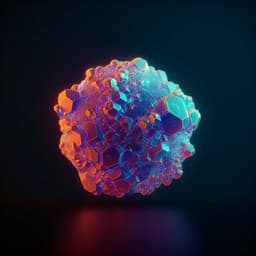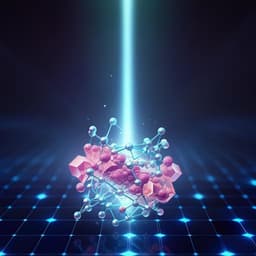
Chemistry
Integrated halide perovskite photoelectrochemical cells with solar-driven water-splitting efficiency of 20.8%
A. M. K. Fehr, A. Agrawal, et al.
Discover the groundbreaking work by Austin M. K. Fehr and colleagues on the innovative conductive adhesive-barrier (CAB) that enhances solar-to-hydrogen efficiencies of perovskite-based cells. Their co-planar design hit an impressive 13.4% efficiency, while a stacked tandem achieved 20.8%, revolutionizing sustainable water-splitting technology.
~3 min • Beginner • English
Introduction
The study addresses the challenge of achieving high solar-to-hydrogen (STH) efficiency and long-term durability in solar-driven water splitting using low-cost, scalable photo-absorbers. Water splitting requires a practical potential of about 1.6 V due to kinetic overpotentials for oxygen and hydrogen evolution, constraining semiconductor choices and device designs. Integrated photoelectrochemical (PEC) devices with protected buried junctions can offer high lifetimes and reduced balance-of-system costs versus decoupled PV–electrolyzer systems. State-of-the-art PECs using III–V multijunctions achieve >19% STH but face high costs and corrosion issues. Metal-oxide-based PECs are scalable but typically show <10% STH and low stability. Halide perovskites (HaPs) are promising low-cost absorbers with high PV efficiencies and sufficient voltage when used in tandem architectures, but their ionic nature makes them unstable in aqueous electrolytes. Prior strategies to protect HaPs (ultrathin surface barriers/catalysts, hydrophobic transport layers, mechanical barriers) preserved current density but typically reduced fill factor and operating voltage, limiting unassisted operation and keeping integrated HaP-PEC STH around ~10.6%. The research question is whether a lossless anticorrosion barrier can protect HaP photo-absorbers while preserving electronic transport to catalysts, enabling efficient and stable integrated PEC water splitting.
Literature Review
The paper reviews key metrics for PECs—stability (lifetime to a fraction of initial efficiency) and STH efficiency—and notes that integrated PECs with buried junctions can reduce costs and improve durability. It summarizes: (i) III–V multijunction PECs exceeding 19% STH but limited by high materials cost, epitaxial growth, and susceptibility to photo-corrosion in acid; (ii) metal oxide PECs (BiVO4, hematite, Cu2O) offering scalability but with STH well below 10% and limited stability; (iii) advances in halide perovskite (HaP) PVs achieving >25% PCE and >1.0 V Voc for 1.5 eV bandgaps, with tandems (HaP/HaP or HaP/Si) exceeding 1.7 V for unassisted water splitting; (iv) previous HaP-PEC protection strategies (ultrathin Ni/TiO2, hydrophobic/doped transport layers, metal foils/graphite sheets/conducting inks) that often lead to fill-factor and operating-voltage losses that prevent unassisted operation. The review identifies the need for a lossless, chemically robust barrier preserving electrical transport and enabling efficient catalysis as a critical gap.
Methodology
The authors designed a conductive adhesive-barrier (CAB), a bilayer comprising: (1) an impermeable, inert, conductive barrier (graphite chosen here; titanium also possible), and (2) a conductive pressure-sensitive adhesive (PSA) formulated from an acrylate copolymer matrix with conductive fillers (carbon or silver nanoparticles) to ensure low-resistance electrical contact to the photovoltaic (PV) top electrode. CAB fabrication involved coating graphite sheets with conductive PSA (spin/spray coating), solvent removal at 100 °C, then drop-casting electrocatalyst inks onto the adhesive side at 60 °C to form CAB-catalyst assemblies.
Two device architectures were implemented:
1) Series co-planar photocathode–photoanode PEC: p-i-n perovskite solar cell (PSC) transformed into a photocathode (ITO/PTAA/Cs0.05FA0.85MA0.1Pb(I0.95Br0.05)3/LiF/C60/BCP/Ag) with a CAB supporting Pt/C (20 wt%) HER catalyst at 0.5 mg cm−2 with Nafion binder; n-i-p PSC transformed into a photoanode (FTO/SnO2/FA0.97MA0.03PbI3/Spiro-OMeTAD/Au) with a CAB supporting nanoparticulate IrOx OER catalyst at 1 mg cm−2 with Nafion binder. Devices were encapsulated with UV-cured epoxy, leaving the catalyst area exposed and matched to the absorber area. Photocathode and photoanode were connected in series electrically and illuminated in parallel geometry. Electrolyte: 0.5 M H2SO4. Faradaic efficiencies (FEs) were measured using a two-compartment flow reactor with online gas chromatography (GC).
2) Monolithic Si/HaP tandem photoanode: A 1.1 cm² perovskite/silicon tandem solar cell (initial PCE ~29%; measured 27.7% before integration; Voc 1.90 V, Jsc 19.2 mA cm−2, FF 0.76 under AM1.5G) was converted into a photoanode by attaching an Ir/IrOx-coated CAB to the silicon face (electrolyte side). The perovskite face was glass-covered and edge-sealed with epoxy; non-active areas on the Si face were encapsulated with epoxy. The device was mounted to a 3D-printed polypropylene PEC reactor. Unassisted operation used a Pt foil cathode in 2-electrode mode.
Photovoltaic characterization: PSC p-i-n achieved PCE 19.1% (Jsc 22.8 mA cm−2, Voc 1.10 V, FF 0.76); n-i-p PCE 20.9% (Jsc 24.4 mA cm−2, Voc 1.13 V, FF 0.76). J–V under AM1.5G, 100 mW cm−2; MPP stability via tracking.
Electrochemical measurements: 3-electrode tests with Ag/AgCl reference (converted to RHE), graphite counter (unless specified), 0.5 M H2SO4 (pH 0.3–0.4), Ar degassing, 10 mV s−1 scans; chronopotentiometry/chronoamperometry for stability; 2-electrode bias-free measurements for unassisted water splitting under AM1.5G illumination. HER Pt/C catalyst showed ~70 mV overpotential at 20 mA cm−2; OER IrOx showed ~370 mV overpotential at 20 mA cm−2. Photocathode and photoanode polarization curves were overlaid to predict unassisted operating current. FE was verified to be ~100% for both HER and OER using GC.
Materials and fabrication details, including PSA synthesis (acrylate copolymerization with benzoyl peroxide initiator; dilution with heptane; conductive filler loading), perovskite layer processing (anti-solvent methods, spin-coating conditions, anneals), electrode evaporation, and reactor design/printing parameters, are provided to support reproducibility.
Key Findings
- The CAB creates a robust physicochemical barrier that preserves photovoltaic performance, translating >99% of PV power to chemical reactions while enabling direct catalyst coupling. CABs are ambipolar, supporting both HER and OER without loss of performance.
- Photocathode (p-i-n PSC + CAB + Pt/C): Under AM1.5G, onset shifted anodically by ~1.1 V (matching PV Voc). Achieved photocathode efficiency of 18.6% with 21 mA cm−2 at 0.87 V vs RHE.
- Photoanode (n-i-p PSC + CAB + IrOx): OER catalyst overpotential ~370 mV at 20 mA cm−2 in 0.5 M H2SO4.
- Series co-planar HaP-PEC (two single-junction devices): Predicted unassisted operating current ~22.1–22.7 mA cm−2 from half-cell curves; measured initial unassisted current ~21.8 mA cm−2. With unity FE, peak STH = 13.4% (total absorber area 0.24 cm²; 2× area contribution). Average current 20.1 mA cm−2 sustained for ~5 h before rapid degradation; across five devices, average STH = 12.4 ± 0.7% with t60 ranging 2–16.3 h. Stability limited by the n-i-p cell (Spiro-OMeTAD HTL degradation), not by the CAB.
- Monolithic Si/HaP tandem photoanode + Pt cathode: In 2-electrode mode, observed ~16.5 mA cm−2 at zero bias vs Pt CE; peak photocurrent ~16.9 mA cm−2 after ~1 h, corresponding to STH = 20.8% (active area 0.44 cm², FE ≈ 100%). Continuous operation for 102 h to t60 ~10 mA cm−2 (STH 12.3%).
- PV performance: p-i-n PSC PCE 19.1% (Jsc 22.8 mA cm−2, Voc 1.10 V, FF 0.76); n-i-p PSC PCE 20.9% (Jsc 24.4 mA cm−2, Voc 1.13 V, FF 0.76). Tandem PV (pre-integration): PCE 27.7% (Voc 1.90 V, Jsc 19.2 mA cm−2, FF 0.76).
- Faradaic efficiencies: Verified ≈100% for HER (Pt-based) and OER (Ir-based) catalysts in 0.5 M H2SO4 and for the tandem photoanode system via online GC.
- Record metrics: The co-planar HaP-PEC achieved the highest reported STH for single-junction HaP-based integrated PECs to date, and the Si/HaP tandem PEC is, to the authors’ knowledge, the first non-concentrator integrated PEC exceeding 20% STH, with high t60 and cm²-scale active area.
Discussion
The CAB addresses the core limitation of integrating halide perovskites with aqueous electrolytes by providing a lossless, conductive, impermeable barrier that preserves PV performance while enabling direct catalyst interfacing. This allows HaP-based PECs to operate unassisted at high current densities, translating PV power efficiently into chemical fuel production. In the co-planar architecture, performance is limited by the single-junction current and by the stability of the n-i-p (Spiro-OMeTAD-based) device rather than the CAB, demonstrating that the barrier does not impose significant resistive or catalytic penalties. Switching to a monolithic Si/HaP tandem overcomes the photovoltage/current mismatch inherent to series two-device architectures and achieves a peak STH of 20.8% with extended operation until t60 at 102 h. Degradation analysis indicates contributions from both the electrocatalysts (IrOx delamination/oxidation at the graphite interface; rising electrolyzer voltage from 1.6 to 1.8 V at 15 mA cm−2) and the PV stack (e.g., LiF interlayer-related PV decay over long operation), suggesting that further gains are feasible by optimizing catalyst adhesion, barrier surface conductivity, and PV interlayers. The CAB’s materials flexibility (graphite or Ti barriers; carbon or metal filler adhesives) and modular deposition strategy make it broadly applicable to other photo-absorbers and reactions, with potential system-level advantages (thermal integration, modularity, reduced BOS costs) over PV–electrolyzer decoupled systems.
Conclusion
This work introduces a conductive adhesive-barrier (CAB) that enables near-lossless integration of halide perovskite photovoltaics with aqueous electrochemistry, achieving record STH efficiencies in integrated PEC devices. A co-planar HaP photocathode–photoanode system reached 13.4% STH (t60 up to 16.3 h), and a monolithic Si/HaP tandem photoanode delivered 20.8% STH with 102 h to t60, all with unity Faradaic efficiency. The CAB is ambipolar, scalable, and compositionally flexible, offering a generic pathway to protect sensitive photo-absorbers while preserving electronic transport to catalysts. Future research should target: improving HaP device stability (especially HTLs in n-i-p architectures), optimizing catalyst/barrier adhesion and surface conductivity to prevent delamination, reducing precious metal loadings and developing non-PM catalysts, refining interlayers in tandems to mitigate PV degradation, and advancing reactor designs and module-scale integration, potentially with solar concentration.
Limitations
- Stability in the co-planar architecture is limited mainly by the n-i-p PSC (Spiro-OMeTAD hole transport layer degradation, exacerbated by air exposure during CAB deposition/epoxy encapsulation), not by the CAB itself.
- In the tandem system, degradation arises partly from electrocatalyst issues (IrOx delamination from graphite; surface oxidation increasing contact resistance; electrolyzer cell voltage drift from ~1.6 to ~1.8 V at 15 mA cm−2) and partly from PV stack degradation (e.g., LiF interlayer contributing to PCE loss over extended operation under MPP conditions).
- Active areas are sub-cm² to ~1 cm²; long-term stability and performance at larger scales and under real outdoor conditions remain to be demonstrated.
- While CAB materials are flexible, only graphite barriers and specific catalyst loadings (Pt/C, IrOx) in acidic media were demonstrated; performance in neutral/alkaline electrolytes, with alternative barriers (e.g., Ti) or non-precious catalysts, requires validation.
Related Publications
Explore these studies to deepen your understanding of the subject.







